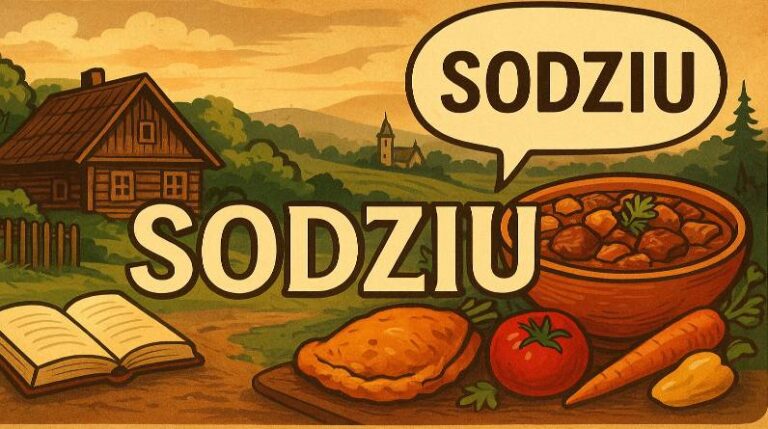Lithuania is a country rich in history, language, and tradition. Among its treasures, Sodziu stands out as a multifaceted symbol that bridges culture, language, and gastronomy. Whether you encounter it as a word in conversation, a hidden village, or a culinary destination, Sodziu represents the heart of Lithuanian identity. In this article, we explore its linguistic depth, cultural heritage, natural beauty, and gastronomic delights, offering a holistic understanding of why Sodziu matters today.
What is Sodziu?
Sodziu (also spelled žodžiu) is more than just a term or a place — it embodies multiple layers of Lithuanian life.
1. Linguistic Expression
In conversation, sodziu literally means “in a word” or “to sum it up,” but it is far more than a simple filler. Its uses include:
- Signaling Finality: “Sodziu, that’s all we could do.”
- Marking Reflection: “Sodziu… I needed to think it through.”
- Transition or Resignation: “Sodziu, it didn’t work out this time.”
Unlike English filler words such as “well” or “so,” sodziu carries emotional weight, offering speakers a moment to express subtle feelings, from thoughtfulness to philosophical acceptance. It is a cultural fingerprint, reflecting Lithuania’s value of introspection and mindful communication.
2. Geographic and Cultural Identity
Beyond language, Sodziu is a quaint Lithuanian village, rich in history and natural beauty. Key characteristics include:
- Traditional Wooden Architecture: Structures dating back generations preserve the charm of rural life.
- Cultural Heritage: Local festivals, folklore, and music sustain centuries-old traditions.
- Community Spirit: The village thrives on social events and gatherings that strengthen ties among residents.
Sodziu serves as a living museum of Lithuanian heritage, illustrating how language, customs, and daily life are intertwined.
3. Culinary Destination
Sodziu also appeals to travelers through its culinary offerings, blending traditional and regional flavors:
- Signature Dish: Sodziu stew – a hearty, slow-cooked blend of meats, vegetables, and local spices.
- Street Food & Pastries: Savory snacks and sweet treats like honey and nut pastries.
- Local Markets: Seasonal produce and handmade goods offering immersive food experiences.
Culinary exploration here is not just about taste but connection — every meal tells a story of culture, craftsmanship, and community.
Sodziu’s Role in Modern Lithuanian Culture
While Sodziu preserves tradition, it has also found a modern identity:
1. Digital and Social Media Presence
- Younger generations use sodziu in memes or online posts, often to express humor or relatable daily struggles.
- Influencers showcase the village’s natural beauty and culinary experiences on platforms like Instagram, amplifying its appeal globally.
2. Tourism and Cultural Preservation
The village has become a destination for those seeking authentic Lithuanian experiences:
| Feature | Description |
| Scenic Landscapes | Rolling hills, forests, and tranquil rivers ideal for hiking and reflection |
| Festivals & Arts | Traditional music, dance, and craft exhibitions |
| Culinary Experiences | Local markets, eateries, and signature dishes showcasing heritage |
| Educational Opportunities | Workshops on language, crafts, and regional dialects |
Tourism in Sodziu emphasizes sustainability and authenticity, ensuring that cultural heritage thrives even as more visitors arrive.
Linguistic Significance: More Than Words
The word sodziu itself offers insight into Lithuanian culture:
- Untranslatable Depth: While English approximations exist (“so anyway” or “in a word”), none capture its emotional and cultural nuance.
- Phonetic Appeal: Linguists note the melodic flow of sodziu, reflecting the region’s linguistic traditions.
- Connection to Identity: For Lithuanians abroad, using sodziu can evoke nostalgia and reinforce cultural belonging.
This duality — being both a word and a place — highlights Lithuania’s unique way of embedding meaning into language and geography.
Experiencing Sodziu: A Practical Guide
For travelers, understanding sodziu is both literal and experiential. Here’s how to make the most of a visit:
1. Exploring the Village
- Walk through the traditional wooden streets to appreciate historic architecture.
- Visit local festivals to see dance, music, and craft traditions alive.
- Engage with locals to understand dialectical variations and oral histories.
2. Culinary Highlights
- Must-Try Dish: Sodziu stew — slow-cooked with local herbs and meats.
- Street Food: Savory pastries and grilled delicacies at open-air markets.
- Desserts: Honey and nut pastries unique to the region.
3. Nature and Outdoor Activities
- Hiking trails across rolling hills and forested areas.
- Scenic photography opportunities at rivers, meadows, and historical landmarks.
- Cycling routes for more independent exploration.
4. Insider Tips
- Visit during off-peak seasons for a more serene experience.
- Learn basic Lithuanian phrases; locals appreciate effort and hospitality.
- Limit phone use during meals — immerse in flavors and conversations.
Why Sodziu Matters in a Globalized World
In today’s interconnected world, unique cultural expressions risk being homogenized. Sodziu matters because it:
- Preserves Linguistic Heritage: A single word carries centuries of cultural nuance.
- Maintains Traditional Practices: Festivals, crafts, and cuisine remain central to community life.
- Fosters Cross-Cultural Awareness: Visitors gain insight into Lithuania’s identity and values.
- Encourages Mindful Living: Both the word and the village remind us to pause, reflect, and connect.
By embracing sodziu, Lithuania showcases the importance of balancing modernity with cultural preservation.
Power Words That Define Sodziu
Across its linguistic, cultural, and culinary dimensions, sodziu can be captured by these descriptors:
- Thoughtful – a pause that conveys reflection and sincerity.
- Authentic – a village and food culture that resist homogenization.
- Endearing – warm, personal, and inviting.
- Serene – natural landscapes offering peace and reflection.
- Cultural – a living embodiment of traditions, language, and heritage.
Conclusion
Sodziu is a unique Lithuanian treasure that transcends a single definition. It is a word, a place, and a culinary experience, each reflecting aspects of identity, tradition, and human connection. From the subtle depth of the word in conversation to the scenic village and its rich gastronomy, Sodziu illustrates how culture, language, and environment can intersect beautifully.
In a world that often prioritizes speed over depth, Sodziu reminds us of the value of slowing down, savoring the moment, and appreciating the layers of meaning in every word, dish, and landscape. Whether you’re a linguist, a traveler, or a foodie, Sodziu promises a profound and memorable experience that is unmistakably Lithuanian.
Frequently Asked Questions (F.A.Qs):
- What does Sodziu mean?
Sodziu literally translates to “in a word” or “to sum it up” in Lithuanian. It also carries cultural and emotional nuance, acting as a thoughtful conversational pause. - Is Sodziu a place or just a word?
It is both. Sodziu is a linguistic term in everyday Lithuanian speech and the name of a charming village known for its culture, nature, and culinary heritage. - What can I experience in the village of Sodziu?
Visitors can enjoy traditional wooden architecture, folklore festivals, scenic landscapes, regional cuisine, and local markets showcasing crafts and food. - What are the must-try foods in Sodziu?
Signature dishes include Sodziu stew, savory pastries, grilled delicacies, and desserts like honey and nut pastries. Local markets and eateries offer a wide culinary variety. - How is Sodziu significant to Lithuanian culture?
Sodziu represents both language and heritage, reflecting thoughtfulness, community spirit, traditional customs, and the preservation of unique regional identity. - How can I use the word Sodziu like a local?
Use it at the beginning, middle, or end of sentences to summarize, reflect, or transition. Example: “Sodziu… I did my best” or “We tried everything, sodziu.” - Is Sodziu accessible for tourists?
Yes. It’s reachable by road or rail, with accommodations including guesthouses, boutique hotels, and Airbnb options. Walking, cycling, and local transport make exploring easy.
For more insightful articles and the latest updates, keep visiting Hacoo.

